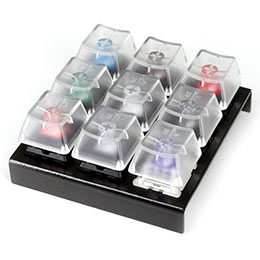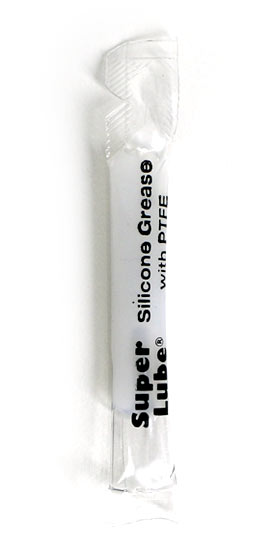
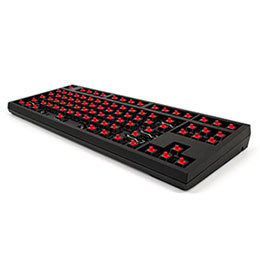
What are mechanical keyboards?
⚡ TL;DR Mechanical keyboards use mechanical switches to register keystrokes instead of a rubber pad on a printed circuit board.
Mechanical keyboards use small mechanical switches to actuate the keystrokes, each key has its own dedicated mechanical switch which allows for a much more tactile feel when typing in comparison to typical keyboards that you're used to.
Typical keyboard use rubber dome technology which is similar to that in your TV remote. They're inexpensive but they don't provide much tactile feedback and subsequently feel "mushy" or "spongey". A single rubber membrane covers the printed circuit board so the key must be fully depressed to actuate the keystroke.
All WASD Keyboards use mechanical Cherry MX switches for each individual key. These switches are of the highest quality, offering a life span of over 50 million operations and feature gold plated contacts. They come in different configurations so the user can choose which one fits their typing style the best. Each mechanical switch is mounted to a heavy steel backplate and then soldered to the PCB for a very solid feel while typing.
Please check out our selection of Mechanical Keyboards:
What are the benefits of a mechanical keyboard?
⚡ TL;DR The feel of the switches! You will actually want to type just to experience the satisfying sensation of the mechanical switches beneath your fingers.
Feel
The main benefit of a mechanical keyboard is the way it feels. With rubber dome style keyboards, you have to "bottom out" a key, meaning you have to fully depress the key, for it register. With mechanical switches, the actuation point is much higher in the key stroke allowing you to quickly change keys without pressing the key down all the way. This allows for less finger fatigue and faster transitions to the next letter.
Each switch type has its own distinct characteristics, so you can choose a switch that would best suit your personal preference. Whichever switch you decide to use, you can be sure that the overall feel and response of a high quality mechanical keyboard will be an experience you won't be able to live without.
Durability
The Cherry MX mechanical switches feature a 50 million operation life cycle. Your average rubber dome keyboard has a life cycle of 5-10 million. WASD mechanical keyboards also mounts the switches to a thick steel plate before the switches are soldered to the PCB. This provides a more stable typing platform and gives the keyboard its rigid body and heavy weight. You can expect many years of use on your mechanical keyboard.
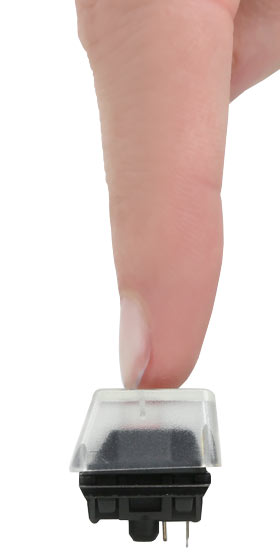
Which switch is the best?
⚡ TL;DR The one that you like the best, personally. No really that's it.
There is no universally regarded "best" switch, but there is definitely a best switch for you personally. Deciding upon what switch type best fits your typing style and preference can seem daunting initially.
The best way to figure out which switch is right for you is to try them out. If you don't have access to a retail store, LAN party, or a friend that can let you try their mechanical keyboard then the next best thing is to pick up a purpose built switch tester: 9-Key Switch Tester. This switch tester will let you get a feel for what each switch type feels like, how they sound and also whether or not o-ring dampeners are right for you.
Cherry MX mechanical key switch comparison

Cherry MX Blue (Tactile Click)
Strong tactile feedback. Audible click. 50g actuation force.
The MX Blue switch is usually reminds people of the old "clicky" keyboards from the early PC days. The combination of the strong tactile feedback and simultaneous click gives a very satisfying feel while typing. However, the clicking can be loud, which can limit its use in shared computing spaces.
Plate Mounted: MX1A-E1NN
PCB Mounted: MX1A-E1NW

Cherry MX Brown (Tactile Bump)
Light tactile feedback. No click. 45g actuation force.
The MX Brown switches can be considered a lighter version of the MX Blue switch without the audible click. The tactile bump not as nearly as distinct, but it does still provide enough feedback for your fingers to detect when the switch has been activated.
Plate Mounted: MX1A-G1NN
PCB Mounted: MX1A-G1NW

Cherry MX Red (Linear)
No tactile feedback. No click. 45g actuation force.
The MX Red switches are almost identical to the Black switches, but have a softer spring for a much lower actuation force. Although this switch has the same actuation force as the Browns, it feels lighter due to the linear action. Also commonly marketed as a "gamer" switch.
Plate Mounted: MX1A-L1NN
PCB Mounted: MX1A-L1NW

Cherry MX Black (Linear)
No tactile feedback. No click. 60g actuation force.
MX Black switches are linear switches, so they have no tactile feedback unless the switch is "bottomed out," meaning the switch is pressed all the way down. The keystroke is smooth all the way down. The stronger spring is said to help the switch reset faster, which can be useful in some instances where "double tapping" is needed. The stiffer switches may also help with accidental key presses from straying fingers. Commonly marketed as a "gamer" switch.
Plate Mounted: MX1A-11NN
PCB Mounted: MX1A-11NW

Cherry MX Clear (Tactile Bump)
Light tactile feedback. No click. 65g actuation force.
The MX Clear switches can be considered a stronger version of the MX Brown switch. The tactile bump is as more distinct than MX Browns and provides more feedback for your fingers to detect when the switch has been activated.
Plate Mounted: MX1A-C1NN
PCB Mounted: MX1A-C1NW
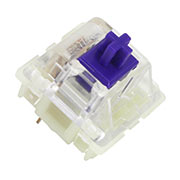
Zealio 67g (Tactile Bump)
Light tactile feedback. No click. 67g bottom-out force.
The Zealios switches can be considered a stronger version of the MX Brown switch, but with a more pronounced bump like a MX Clear. The tactile bump is as more distinct than MX Browns and provides more feedback for your fingers to detect when the switch has been activated. All this while having a softer spring that is easier on your fingers.

Cherry MX Speed Silver (Speed Linear)
No tactile feedback. No click. 45g actuation force.
MX silver speed switches are linear switches, so they have no tactile feedback unless the switch is "bottomed out," meaning the switch is pressed all the way down. The keystroke is smooth all the way down. The speed switches have a reduced stroke travel than other MX linear switches to allow you to bottom out more quickly, thus engaging the switch more quickly. Commonly marketed as a "gamer" switch.

Cherry MX Silent-Red (Silent Linear)
No tactile feedback. No click. 45g actuation force.
The MX Silent-Red switches are almost identical to the Red switches, but have a unique internal damper for even quieter operation. If you're looking for the most silent switch we offer, this is the switch to get.
Plate mounted vs. PCB mounted switches
⚡ TL;DR PCB mount switches have little molded-in tabs that help them stabilize when a metal plate is not present.
Cherry MX switches are mounted to the keyboard via two popular methods; plate mounted and Printed Circuit Board (PCB) mounted. The most common method for mounting Cherry MX switches to a keyboard is plate mounted. This method allows the housing of the switch to grasp a metal or plastic plate providing a very secure mount, then the switch is soldered into the PCB below the plate. PCB mounted switches have a different molded housing with two prongs that allow it to pass through the PCB before being soldered, these prongs aid in stability when the switch is mounted directly to the PCB.
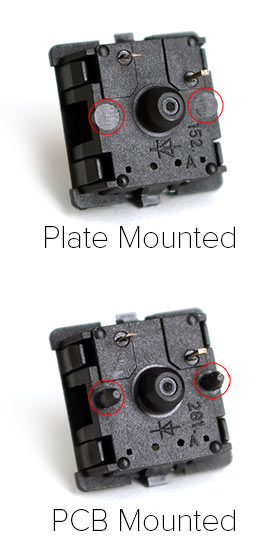
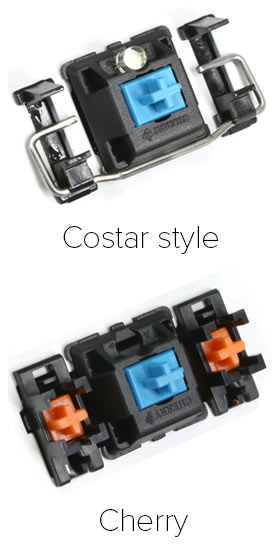
Costar style vs. Cherry stabilizers
⚡ TL;DR Both stabilize your larger keys, just in slightly different ways.
The large keycaps on a mechanical keyboard need stabilization so that when you press on one side of the keycap or the other it remains balanced. This is achieved by a metal bar that connects one side of the keycap to the other. There are two major designs when it comes to large keycap stabilization Costar style and Cherry.
Costar Style:
The Costar style stabilizer setup features plate mounted stabilizer clips that attach to the plate, then hold a metal stabilizer spring (or bar). The large keycaps that are being stabilized must have stabilizer inserts pressed into the keycap to then accept the stabilizer bar before the keycap is then pressed onto the switch. The drawbacks are that the keycaps can be a bit trickier to install on Costar stabilizersin comparison to Cherry.
Cherry:
The Cherry stabilizer setup features a stabilizer bar mechanism similar to the Costar setup, however Cherry integrates the stabilizer inserts so that they do not come off the stabilizer setup when the keycap is removed. This benefits of this design is that it makes installing or removing keycaps very easy. The drawback of the Cherry stabilizer setup is that it colors your switch actuation as stiffer when depressing your keycap and provides a mushier feeling when bottoming out the keycap as per compared to the alternative.
Keycap material
⚡ TL;DR ABS is the most prevelant due to low cost and ease of manufacturing. PBT and POM are generally more durable but also more expensive.
ABS:
ABS (Acrylonitrile Butadiene Styrene) plastic is the most common keycap material due to its low cost and ease of injection molding manufacturing. ABS is impact resistant, lightweight and very durable. Uncoated ABS keycaps are more prone to becoming shiny over time than more expensive alternatives, however our unique UV coating process is much more resistant to key shine than bare ABS.
PBT:
PBT (Polybutylene Terephthalate) is less common than ABS for keycaps due to its higher cost. PBT keycaps have a more "chalky" feel to them than ABS. PBT keycaps are also are more resistant to key shine than ABS due to a higher abrasion resistance. PBT is also known for being heavier in weight than ABS.
POM:
POM (Polyoxymethylene, also known as Acetal) is even less common than PBT for keycaps due to a higher cost of manufacturing. POM keycaps have similar properties to PBT with both resistance to key shine and heavier weight per compared to ABS. POM has high strength, hardness and rigidity.
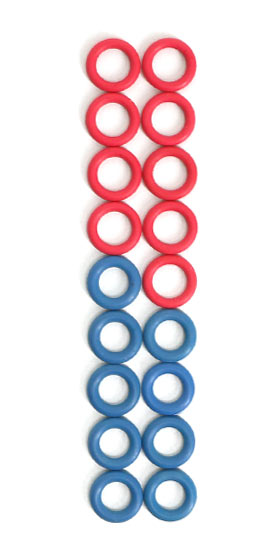
Using O-ring sound dampeners
⚡ TL;DR You can quiet down your typing with some o-ring dampeners.
Some people may find that mechanical keyboards are a bit too noisy for their preference. WASD Keyboards offers different rubber O-ring sound dampeners that can be installed onto the keycaps to dramatically reduce the sound created from when a switch is fully depressed or "bottomed out." Typically, when a switch is pressed all the way, the bottom of the switch stem hits against the switch casing creating a "clack" sound. An O-ring will eliminate this clack by stopping the stem from going all the way down. O-rings do slightly reduce the key travel by less than 0.5mm and creates a "soft landing" when you bottom out. Some users find the softer landing more comfortable and easier on the fingers and hands.
Please watch our Cherry MX Switch Sound Comparison video to demonstrate the different sounds of each Cherry MX switch type and with and without sound dampeners installed.
Marketing hype
⚡ TL;DR Some manufacturers will try to sway your purchase with buzz words or features that aren't as important as they claim them to be.
WASD Keyboards focus is to provide quality mechanical keyboards. We do not use any fancy marketing terms to trick you into thinking our keyboard is superior. Here are some things to look out for:
Key polling rate - Although this can make some difference in mice, it is largely irrelevant for keyboards. Even the fastest typist in the world wouldn't see any difference by increasing the polling rate of a keyboard. With Key Rollover, multiple key strokes, even when pressed together in between scan cycles, will be recognized in the correct order during the next scan cycle.
Gold plated connectors - Gold plated connectors makes no noticeable difference in connectivity or latency. If anything, it would be more important to look at cable shielding and overall length. Too long of a cable without proper shielding can cause a weak signal.
Gaming matrix - This is similar to Key Rollover, but is far inferior. To save costs, some keyboards are designed so that only certain areas of the keyboard can register more keys at once rather than offering the true Key Rollover achieved by adding diodes to the circuit.
Anti-ghosting - This is sometime used in place of Key Rollover, but the terminology is incorrect since ghosting is a different (and rare) issue. You will need to do more research to see what key rollover technology is being used. Ghosting is when two or more keys are pressed and a key that was not pressed registers instead.
General cleaning
⚡ TL;DR A clean and well-maintained keyboard will work better and look better than one that isn't.
Keeping your keyboard clean and free of dirt and dust will prolong the life of both your keyboard and keycaps.
First, dust off your keyboard with compressed air, be sure to spray between the keycaps to try to remove any dust and debris that may have fallen below your keycaps.
Next, we recommend using a diluted blend of 70% isopropyle alcohol and water. Mix a 50/50 ratio of alcohol to water, this will clean more thoroughly and evaporate more quickly than water, but not harshly affect painted surfaces such as the keyboard case. Lightly dampen a clean towel and wipe both your keycaps and keyboard until they are clean, you can use more cleaning solution on tougher areas.
It's a good idea to remove all your keycaps for a more thorough cleaning once a year or as needed. This will allow you to get all of the dust and debris that has accumulated over time beneath your keycaps and also give you access to clean the plate or PCB.
Lubricating large keys
⚡ TL;DR If your larger keys are squeaking or rattling, adding some lubrication can be the fix.
Sometimes you may need to grease your larger keys if they are noisey, or don't feel as smooth as they should. We recommend silicone grease for best results, but any grease that is safe for plastic will work.
First, remove the keycaps that are in need of greasing (Check out our how-to remove keycaps video below).
Next, lightly grease the stabilizer inserts. Grease the inner part of the stem where it mates with the stabilizer bar, and also grease the outsides of the stabilizer inserts where it mates with the plate mounted clip.
Install your keycap back on your keyboard and actuate the switch a few times to test. If you're still hearing a noise, or feeling any grit, remove the keycap again and regrease. The action of your keycap and switch should feel smooth without any noise or binding.
Removing and installing keycaps
This video will help you remove and install keycaps.
Remapping software
⚡ TL;DR You can set up your keyboard how you want it using some remapping software.
Using key remapping software, your keyboard can be set up to suit your needs exactly.
Some of the most popular apps are available for your favorite OS.
Windows:
AutoHotKey
SharpKeys
Microsoft Keyboard Layout Creator
Mac OSX:
Karabiner
Linux:
AutoKey
There are also many other alternatives available.
Don't use your caps lock key? How about assign it to a key that is more useful? Wondering what the scroll-lock key actually does or why it's taking up space on your keyboard? Assign it to a key or macro that is helpful!
Aside from the simple task or reassigning keys, these powerful programs can automate complex tasks with a simple hotkey command. Define your own custom macros and keybind repetitve tasks to be performed with a click of your keyboard. Increase your productivity and efficiency by becoming a hotkey master.


